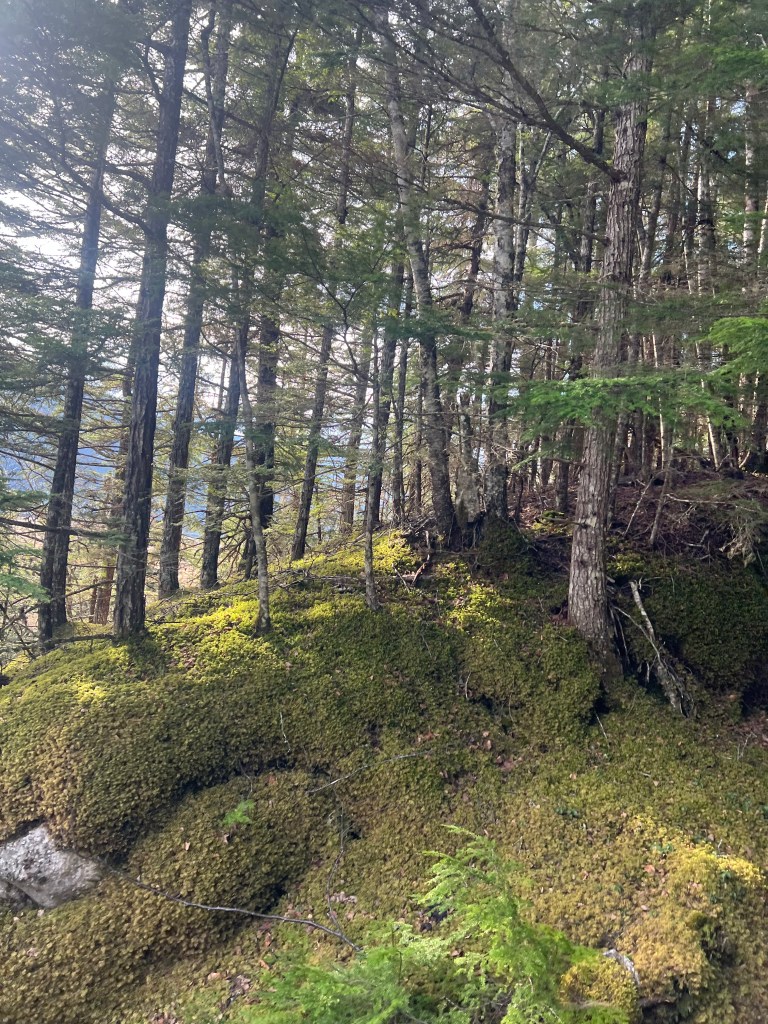Sunday 7 May 2023
Skagway is a very small picturesque city (population 1200) with it’s buildings maintained in the 1800s era style – the time of the Gold Rush – saloons, steam locomotives and whore houses. On our trip we were destined for higher altitudes to go dog sledding. Alaska has a turbulent history of lives and land being stolen from the first nation people by the pioneers for land and its resources. All the tours we had acknowledged the first owners of the land, show cased culture of the first nation people and on our cruise ship we had members of the Tlingit people to explain their history, culture and traditions. Their intimate understanding of the land, animals and plants allowed them to survive the harsh climate.
Along with the incredible vistas of snow-topped mountains, forests and river, I noticed the incredible deep carpets of moss in the forests. We went up past Dyea, an abandoned town with a turbulent history, to the Alaska Sled Dogs and Mushers Camp. The dog sled experience was incredible, racing through track surrounded by established forests with moss covered floors.
In Robin Wall Kimmerer’s wonderful book: Gathering Moss: A Natural and Cultural History of Mosses, the author talks about the many uses of moss in North America by indigenous people. I had trouble imaging how the would be enough moss for all the uses, but when in the forests of Skagway, I realised what abundance with which moss grows.
The abundance of moss

The mosses that make up the woodland carpet include White-toothed peatmoss (Sphagnum girgensohnii) and Stair-step moss (Hylocomnium splendens). If you click on the scientific names, it will take you to the iNaturalist link, where if you select ‘maps’ you can see the distribution of these mosses globally. They are common to temperate rainforests.

Uses of moss
Mosses have been used by indigenous people in a variety of ingenious ways. Taking the natural properties of moss and applying them to meet human needs. For example, Menzies’ tree moss (Leucolepis acanthoneuron) found only on the Tongass National Forest is a source of yellow dye for baskets.
Other uses of mosses including sphagnum mosses, include:
- waterproofing boats by mixing moss with tar and pushing it between wooden slats
- lining fire pits
- waterproofing roofs of dwellings
- insulation of clothes, shoes and dwellings
- stuffing mattresses and pillows
- stuffing children’s toys
- toilet paper
- antiseptic packing for bandages
- babies nappies
- dried out, excellent kindling to start fires
- sanitary products for women
- filtering water
Moss and commercialisation
Moss is very attractive, so much so many people are now using it for home decor, wall art, terrariums and so on. This commercialisation of moss is particularly concerning, as according to Robin Wall Kimmerer, people are clearing great swathes for moss from their natural habitat to meet the desires for moss in our homes.
Although moss grows very well in it’s natural habitat, it is quite fussy and it can be difficult to support in the dry air of homes. I’ve tried to grow small pieces of moss in a tank at home, but most of it has just become mouldy, dried up or died. Perhaps it is better to just appreciate it in it’s natural space.
The town of Dyea was a hot spot for those searching for gold in the gold rush era. Once more efficient methods for extraction took over and the resources were plundered, Dyea died: what remains is a ghost town. Skagway itself, a small population, still depends on its natural resources of halibut and salmon fishing. To survive, Skagway and the other ports we visited, have diversified to use their natural resources to attract visitors like me from around the world. Most come for the fantastic wilderness and scenery, visiting a glacier by foot, boat or helicopter, the hope of seeing a wild bear, the dog sledding experience, a boat trip to go whale watching. Far fewer, come for the moss.
There is a strong sense of sustainability, the locals are conscious of working with their natural resources: the sled dogs are cared for exceptionally well, the whale tours are managed as to minimise disruption to the whales natural behaviour, and the fishing uses sustainable methods. It is not lost on me the environmental impact of air travel and travelling by cruise ships to visit these places. I find myself in a state of cognitive dissonance when balancing my long-held concerns for the natural world and my desire to experience it’s wonder.
The battle continues
The picture below was taken at a base of a young tree on the edge of the forest in Skagway. It’s beautiful microhabitat, the closer you get, the more detail you see. There are several mosses and lichens growing together on the damp woody stump. They have found just the right conditions in which to flourish, but as with all of nature, they are fighting for survival.

Look out for the fifth blog of the Alaska series: Icy Strait Point
Want more? Follow Moss Safari
Please like and follow this blog and website
